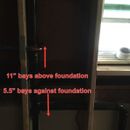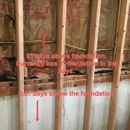Insulating Basement Walls
I’m in Spokane, WA, which is Zone 5 for construction purposes. It is a split level house built in 1970.
We’re finishing our basement (adding a bathroom and finishing the bedroom), and we want to make sure we’re correctly approaching insulation. Thanks in advance for your advice!
Air Sealing
Polyurethane calk in all seams and protrusions.
Bay depths
You can see in the attached photos that:
* Bathroom exterior wall bays are 11″ above the foundation and 5.5″ below the foundation.
* Bedroom exterior wall bays are 9″ above the foundation (currently filled with 2″ faced insulation), and 3.5″ below the foundation.
Insulation
My plan is to use R-15 mineral wool (https://www.homedepot.com/p/Owens-Corning-R-15-Thermafiber-UltraBatt-Unfaced-Mineral-Wool-Insulation-Batt-15in-x-47in-UB-40-P3D-15-47-121/304633821).
I can’t find R-23 due to supply chain issues so my plan is to double / triple the R-15 to meet the required depths.
Bathroom exterior wall
* For the 11″ bays above the foundation, add 3xR15= 10.5”
* For the 5.5″ bays against the foundation, we have two options:
<1> add 2xR15 = 7″, compressing it to 5.5″.
<2> Combine 1xR15 with some old 2″ insulation that had been in the bathroom exterior wall. This would come out to 5.5″)
Bedroom exterior walls
* For the 9″ bays above the foundation, keep the faced 2″ insulation and add 2xR15, for a total depth of 9”. My impression is that we’d want to cut a slash in the facing in the 2″ insulation.
* For the 3.5″ bays against the foundation, add 1xR15 = 3.5″.
Additional Foam Board and Vapor Barrier
We’re concerned about thermal bridging so are thinking about adding a 1/2″ sheet of foam insulation on top of the bays before the sheet rock layer. We’d just add the whole 4′ x 8′ sheets against the studs. Home Depot has R2 and R3 products (https://www.homedepot.com/p/R-Tech-1-2-in-x-4-ft-x-8-ft-R-1-93-Insulating-Sheathing-320810/202533656 and https://www.homedepot.com/p/RMAX-Pro-Select-R-Matte-Plus-3-1-2-in-x-4-ft-x-8-ft-R-3-2-Foam-Insulation-Board-637902/313501506).
We’re pretty clueless about vapor barriers. Would it be advisable to add one somewhere in the layers?
Your feedback on our plan is much appreciated!
GBA Detail Library
A collection of one thousand construction details organized by climate and house part











Replies
Spokane is climate zone 5 for construction purposes. Martin’s basement article is worth a careful read: https://www.greenbuildingadvisor.com/article/how-to-insulate-a-basement-wall.
Thanks Steve - Just updated the zone in my original post. Checking out the article now.
Here's some additional info: https://www.energystar.gov/sites/default/files/asset/document/BSC%20Information%20Sheet%20511%20Basement%20Insulation%20for%20all%20Climates.pdf. The first illustration shows you how to make the rigid foam to air permeable transition when insulating half walls.
A vapor retarder in this situation makes good sense to me. Add these articles to your reading list: Vapor Retarders and Vapor Barriers and Smart Vapor Retarders for Walls and Roofs.